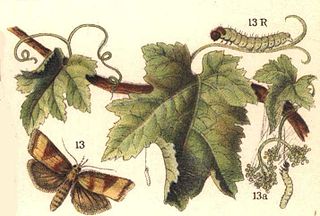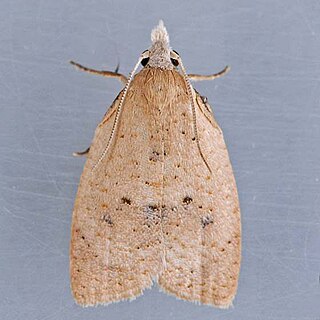
The Sparganothini are a tribe of tortrix moths.

Crocidosema is a genus of tortrix moths belonging to the tribe Eucosmini of subfamily Olethreutinae. They are found mostly in the Southern Hemisphere, being especially common in the Neotropics. But some occur elsewhere, such as on the Hawaiian Islands.
Syllonoma is a genus of moths belonging to the family Tortricidae, first described by Jerry A. Powell in 1985.
Amorbia chiapas is a species of moth of the family Tortricidae. It is found in Mexico in the states of Chiapas, Oaxaca and Veracruz, where it is found at altitudes between 1,700 and 2,300 meters.

Sparganothoides lentiginosana, the lentiginos moth, is a species of moth of the family Tortricidae. It is found in the United States from Maryland to Florida, west to Arkansas, Texas and Oklahoma, ranging south to Mexico in Tamaulipas and Veracruz. It is found in a wide range of habitats, ranging from urban areas to mixed pine-deciduous woodlands at low elevations.
Sparganothoides morata is a species of moth of the family Tortricidae. It is found in Panama, Venezuela and Trinidad.
Sparganothoides torusana is a species of moth of the family Tortricidae. It is found in Mexico (Veracruz) and Costa Rica.
Sparganothoides prolesana is a species of moth of the family Tortricidae. It is found in Costa Rica.
Synalocha gutierreziae is a species of moth of the family Tortricidae. It is found in the United States in Texas, Arizona and New Mexico.
Accuminulia longiphallus is a species of moth of the family Tortricidae. It was first described by John W. Brown in 1999 and is found in Chile.
Eliachna chileana is a species of moth of the family Tortricidae. It is found in Chile in the provinces of Talca, Curicó, Cautín, Malleco and Ñuble.
Quasieulia jaliscana is a species of moth of the family Tortricidae. It is found in the Mexican states of Jalisco, Oaxaca, Puebla and Veracruz.
Pseudapina lanceovalva is a species of moth of the family Tortricidae. It is found in Venezuela.
Paraptila gamma is a species of moth of the family Tortricidae. It is found in Mexico (Tabasco) and Costa Rica.
Eugnosta brownana is a species of moth of the family Tortricidae. It is found in Texas, New Mexico, Arizona and possibly Mexico.

Rudenia leguminana, the black-tipped rudenia moth, is a species of moth of the family Tortricidae. It is found in the United States, from southern Connecticut to Florida, and from the mid-west to California. It is also found in Mexico, where it has been recorded from Sinaloa, Puebla, Nuevo León and Coahuila.
Geogepa monticola is a species of moth of the family Tortricidae. It is found on the island of Honshu in Japan. The habitat consists of subalpine and alpine forests.
Xenothictis gnetivora is a species of moth of the family Tortricidae. It is found in Papua New Guinea.
Acleris longipalpana is a species of moth of the family Tortricidae. It is found in South Korea, China, Japan and Russia (Ussuri).

Spatalistis bifasciana is a species of moth of the family Tortricidae. It is found in most of Europe.




